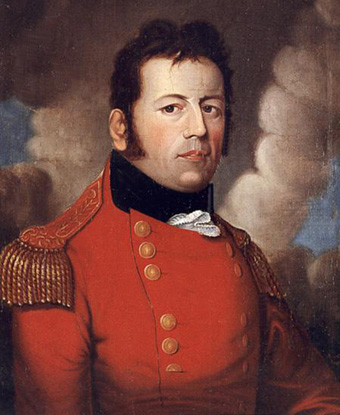Last updated: February 22, 2019
Person
Sir George Prévost

Collection of Museum of Château Ramezay, Montréal
Sir George Prévost was the son of Major General Augustine Prevost of the British army, and encouraged from a young age to take up a career in the army. He was born in colonial New Jersey and educated both in America and in England, enlisting in the 60th Regiment of Foot at the age of 11. As the son of a prominent general and with considerable family wealth, Prévost was able to purchase his promotions (a common practice at the time), allowing him to move up the ranks quickly despite having limited battle experience.
Prévost was promoted to lieutenant colonel by 1794 and stationed in the West Indies on three different occasions during the French Revolution and Napoleonic wars. Although never distinguished as a military commander, here is diplomatic skills began to shine. Prévost was appointed lieutenant governor of St. Lucia in 1798 and later governor of Dominica in 1802. His diplomacy and fluency in French made him popular among the French planter aristocracy and strengthened his reputation. By 1808, Prévost was elevated to the rank of brigadier general and sent to Nova Scotia to serve as lieutenant governor, but he would return to the Caribbean in 1809 to lead a successful campaign to capture the French colony of Martinique.
Bilingual and now a military hero, Prévost was a natural choice to serve as governor of Canada when he returned. In 1811, he was promoted to lieutenant general, given command of the British forces in North America, and named governor of Canada. Prévost’s first order of business as the governor of Canada was to help unite a population divided by language and culture by winning support of the French Catholics in eastern Canada. His second focus was to prepare the colony for impending war with the United States. Prévost quickly appointed Major General Isaac Brock as commander of forces in Upper Canada, and raised two new corps of soldiers while requesting more troops and support to be sent from Britain.
Although high-ranking, Prévost was largely unskilled and inexperienced as a battle commander and preferred passive defense to aggressive attacks as his military strategy. He personally led the raid on the American naval station at Sacket’s Harbor on May 29, 1813, but the failure to take the port, paired with his poor reputation as a tactician left him open to criticism by top British Army officers.
Prévost attempted to take charge again by leading the invasion in the Battle of Plattsburgh in 1814, but this ended disastrously as well. Hundreds of his troops were killed, wounded or captured, and this defeat lost the British hold on the Great Lakes and Lake Champlain. Following the end of the war, Prévost returned to England to answer charges of poor leadership at the Battle of Plattsburgh and face a court martial. He died before the process was completed and never stood trial.
